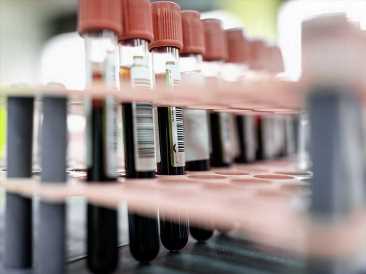Blood test may predict long-term risk of diabetes and heart disease

- A simple blood test may predict long-term risk of type 2 diabetes and cardiovascular disease.
- In a study of 4,000 healthy adults, scientists found that levels of lipids in blood plasma were linked to later development of both conditions.
- Those with higher concentrations of certain blood lipids measured had a higher risk of either type 2 diabetes or cardiovascular disease.
- Lipid profiling may be a cheap, fast way to predict risk, allowing changes to diet and lifestyle before conditions develop.
In the United States, 1 in 10 people has type 2 diabetes. Someone dies every 36 seconds from cardiovascular disease (CVD) in the U.S., and CVD causes one-third of all deaths worldwide.
Both conditions may develop slowly, and the symptoms are not always evident. Doctors assess a person’s risk of developing them by taking a patient history and observing current lifestyle factors.
Now, a study led by Prof. Dr. Chris Lauber, of Twincore in Germany, has shown that lipids in blood plasma can predict future risk of type 2 diabetes and CVD.
The method — known as lipidomic profiling — can provide a quantitative measurement of risk long before symptoms develop.
“The authors of this study have added to the growing evidence that lipidomics profiling could very well usher in the next generation of detection of cardiovascular diseases as well as diabetes.”
– Dr. Suneet Singh, Medical Director of CareHive.
Measuring blood lipids
The longitudinal study included just over 4,000 healthy, middle-aged Swedish people from the Malmö Diet and Cancer-Cardiovascular Cohort.
Participants ranged from 46–68 years at the start of the study. Around 10% had a body mass index (BMI) of more than 30.
The researchers took one baseline blood sample from each participant. They then centrifuged these blood samples to separate out the plasma for analysis.
Researchers measured concentrations of 184 different lipids in the blood plasma using mass spectrometry. They used these lipidomic profiles to calculate risk scores and assign participants into one of six risk groups.
Dr. Singh told Medical News Today the study could add to previous methods of assessing risk:
“This new approach allows for a novel framework of risk stratification which also allows for enhancement when used in conjunction with the measurement of standard clinical variables.”
He did, however, note that there was little diversity in the study population: “It is advisable to continue to expand upon this research by increasing the patient population to include several more variables. This includes different patient ages, racial groups, ethnicities, and physical activity levels.”
Lipids and risk
The researchers followed up participants for more than 20 years from baseline assessments made between 1991 and 1994. In that time, 13.8% of the cohort developed type 2 diabetes, and 22% developed CVD.
For those in the highest risk groups, these values rise to 37% for developing type 2 diabetes and 40.5% for developing CVD as compared to the group averages above.
People in the lowest risk groups had a decreased risk of developing both conditions.
The researchers also found that people with high lipid risk scores had a much greater likelihood of developing obesity during the follow-up period. Obesity is a risk factor for both type 2 diabetes and CVD.
The authors suggest that this risk-score-based approach could indicate the risk of both type 2 diabetes and CVD many years before disease onset.
“[T]his earlier disease detection occurs at a time where the disease has not become clinically evident. As a result, researchers and clinicians can now take on diseases from a more proactive preventive lens and not simply one that starts at the treatment stage,” Dr. Singh commented.
Early warning
Using mass spectrometry to measure blood plasma lipids is quick, relatively inexpensive, and gives quantitative results.
The authors of this study suggest that it could identify lipids that contribute most to the risk of developing subsequent health conditions and, potentially, lead to new drug treatments.
Dr. Singh told MNT: “Research […] demonstrated in this paper helps to advance the field of clinical mass spectrometry as a whole by continuing to demonstrate the potential for earlier disease detection in advance of conventional means.”
The authors stress that further research is needed to verify their hypothesis and demonstrate how informative the plasma lipidome is for health and disease.
“The lipidome may provide insights much beyond diabetes and cardiovascular disease risk.”
– Prof. Chris Lauber, lead author of the study.
So, this simple test could tell people their risk of developing both type 2 diabetes and CVD. By making diet and lifestyle changes, they may then be able to decrease that risk.
Source: Read Full Article
